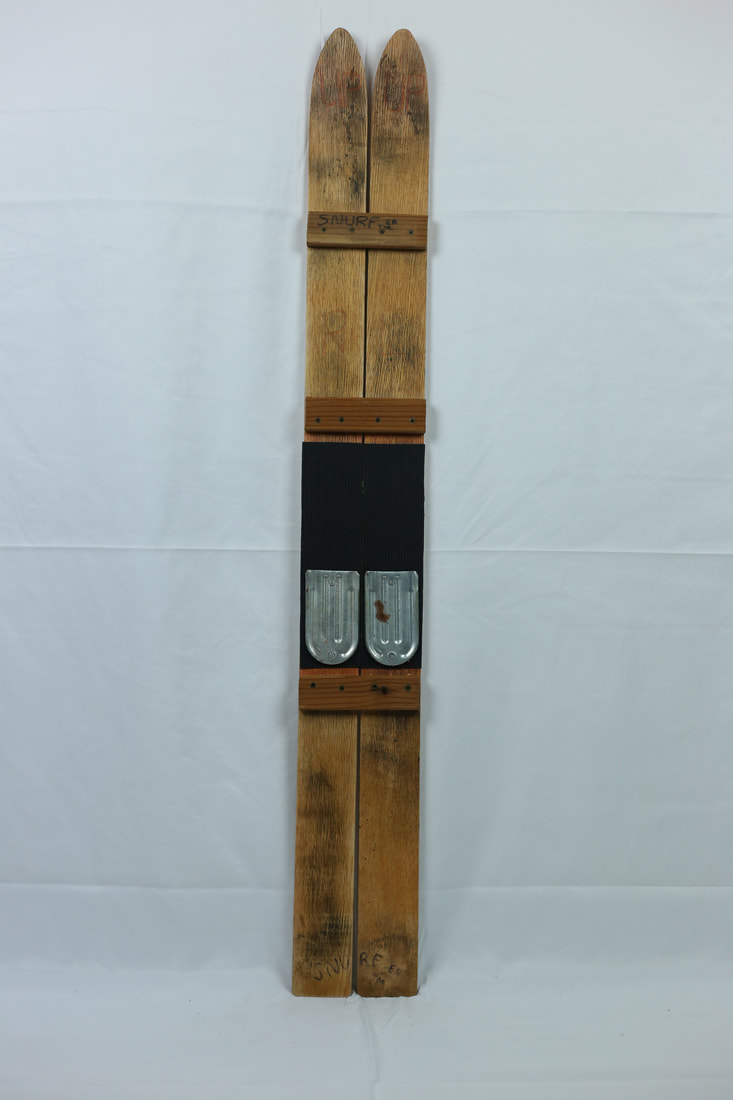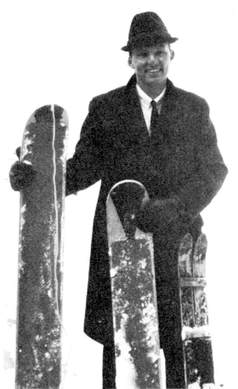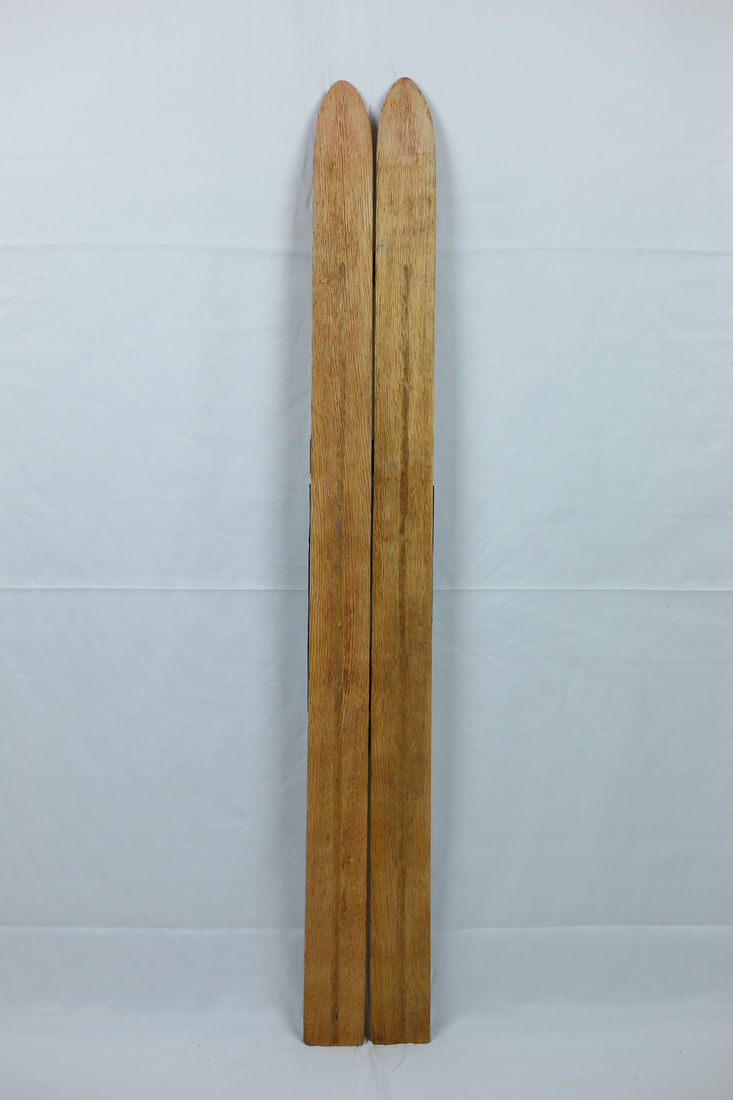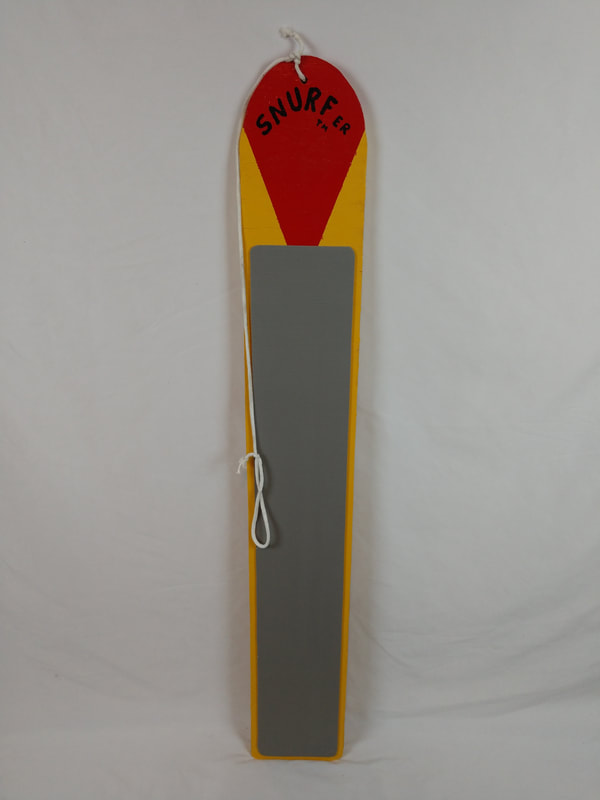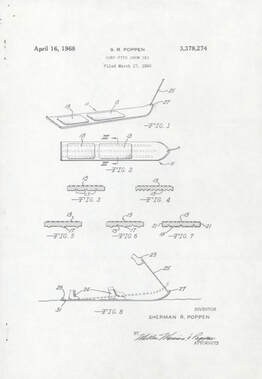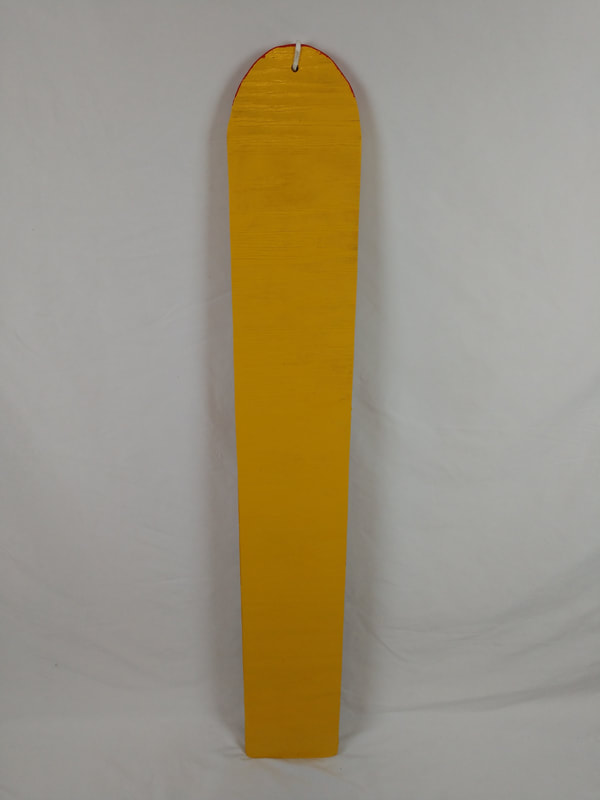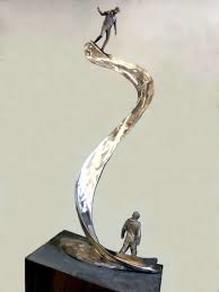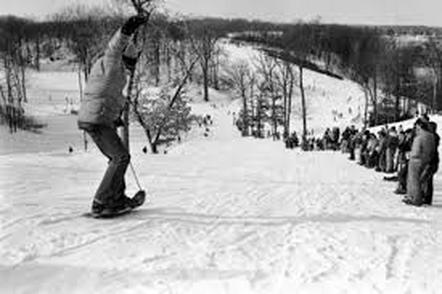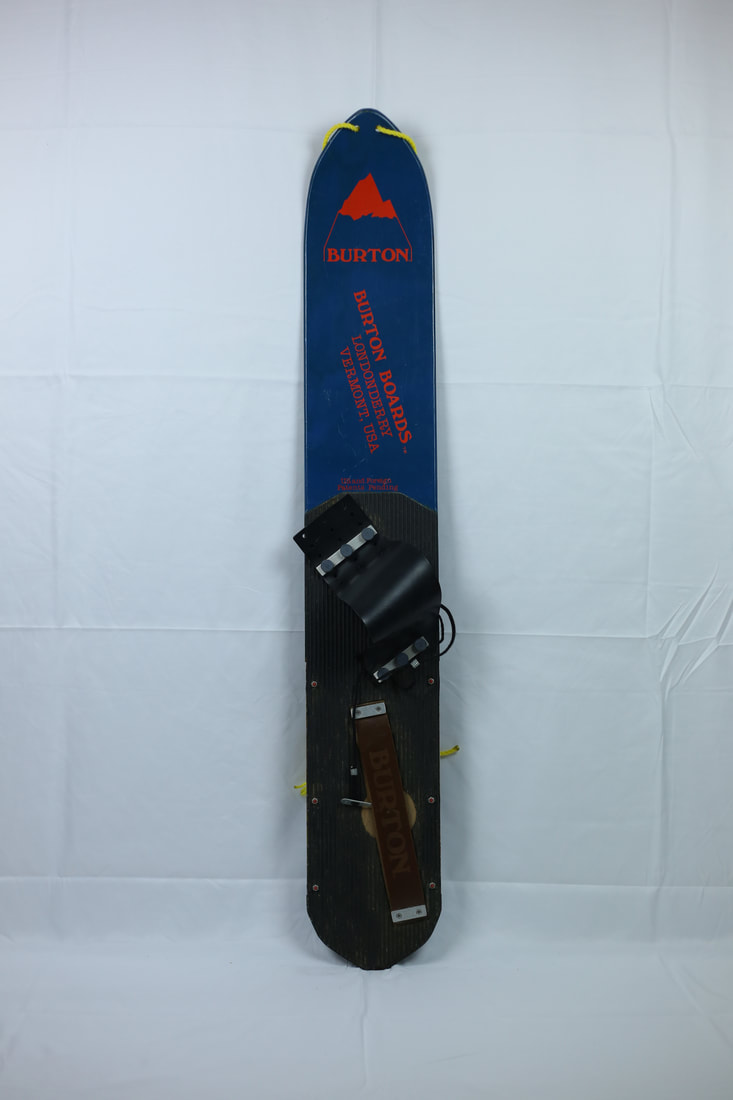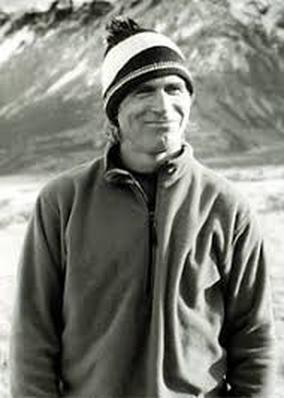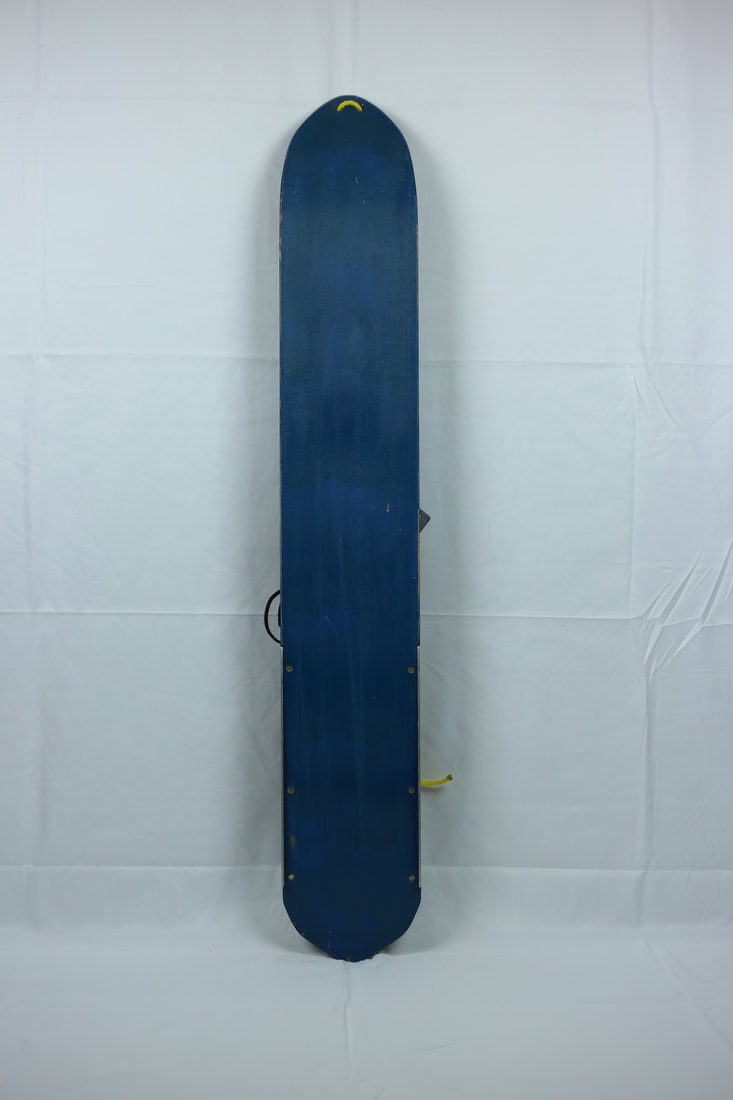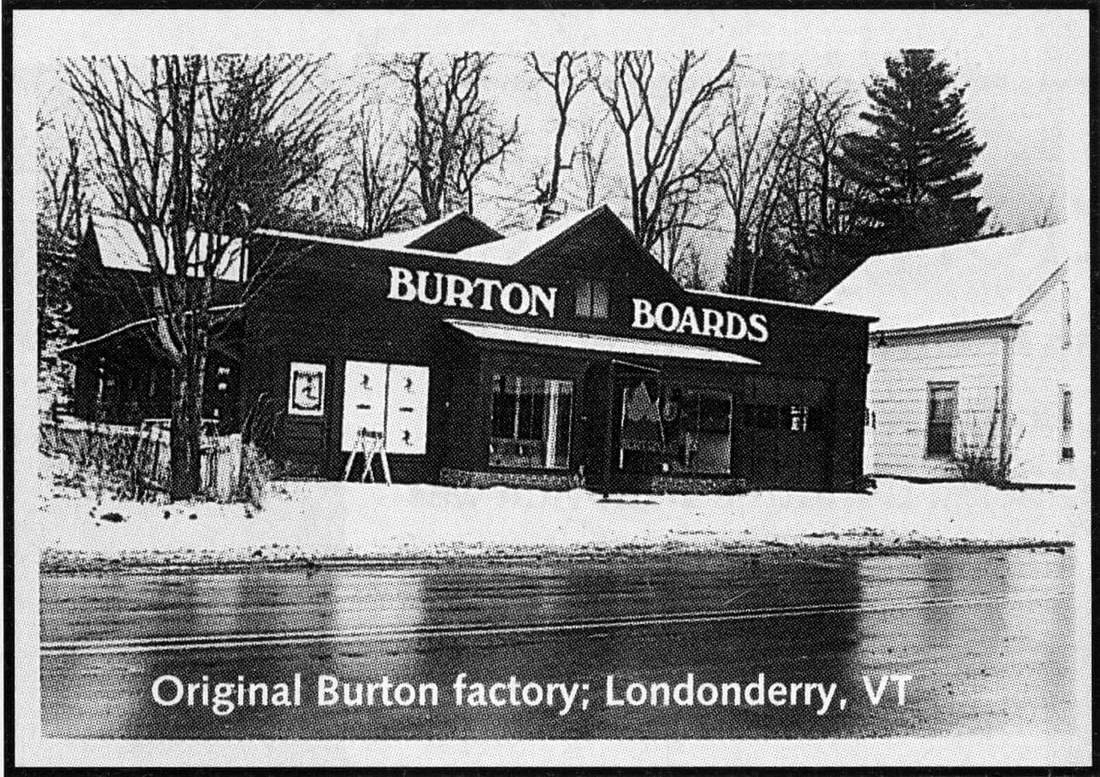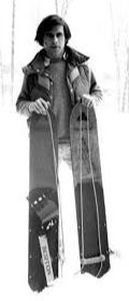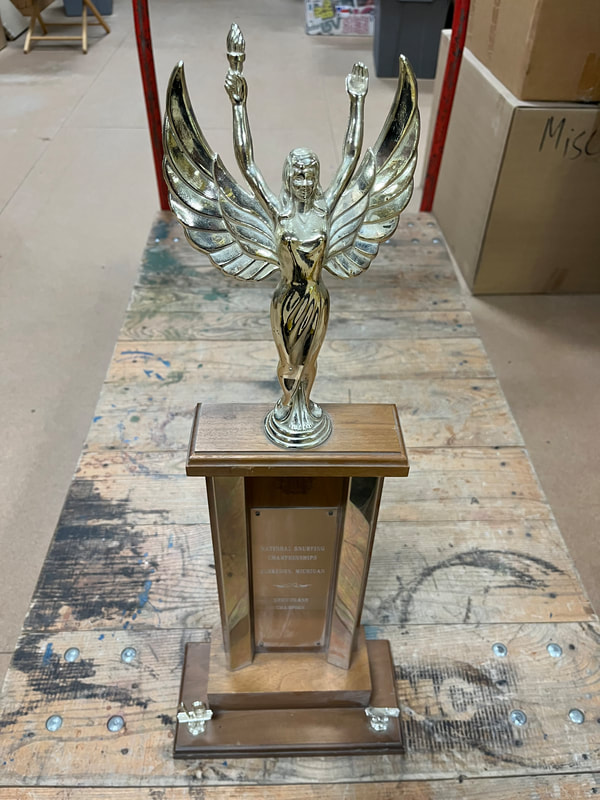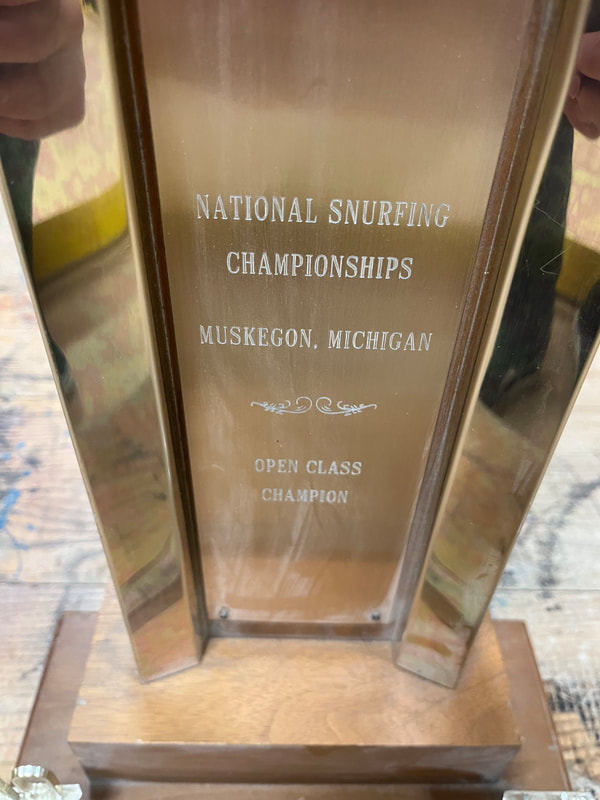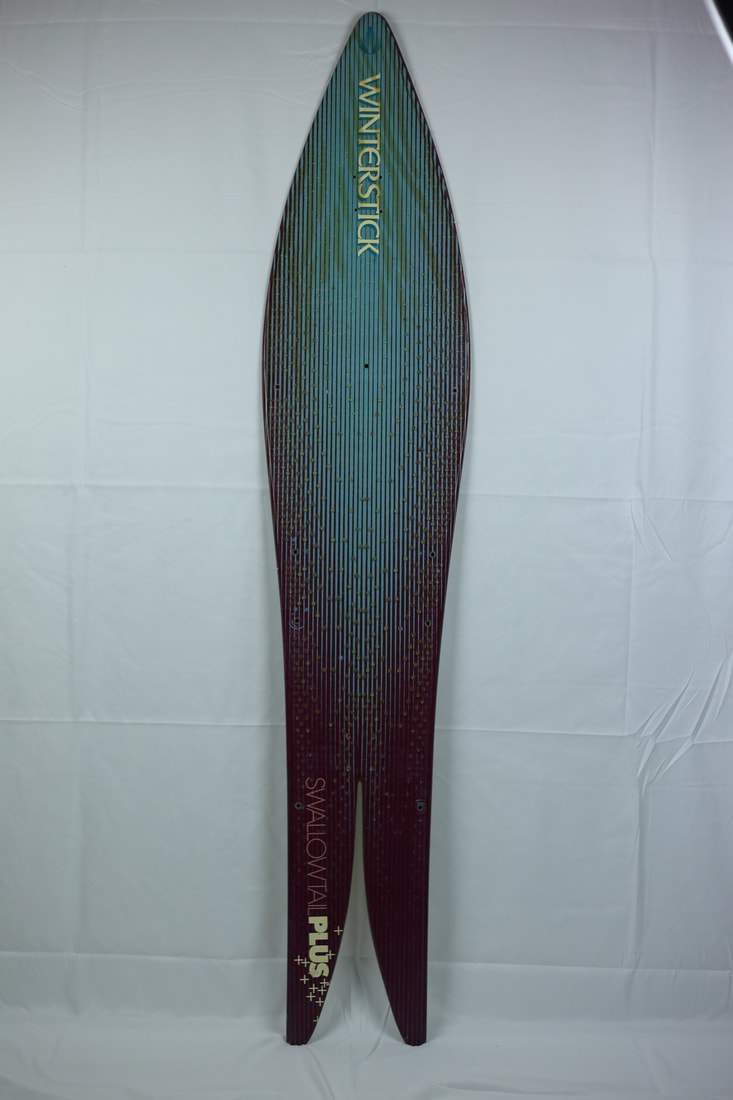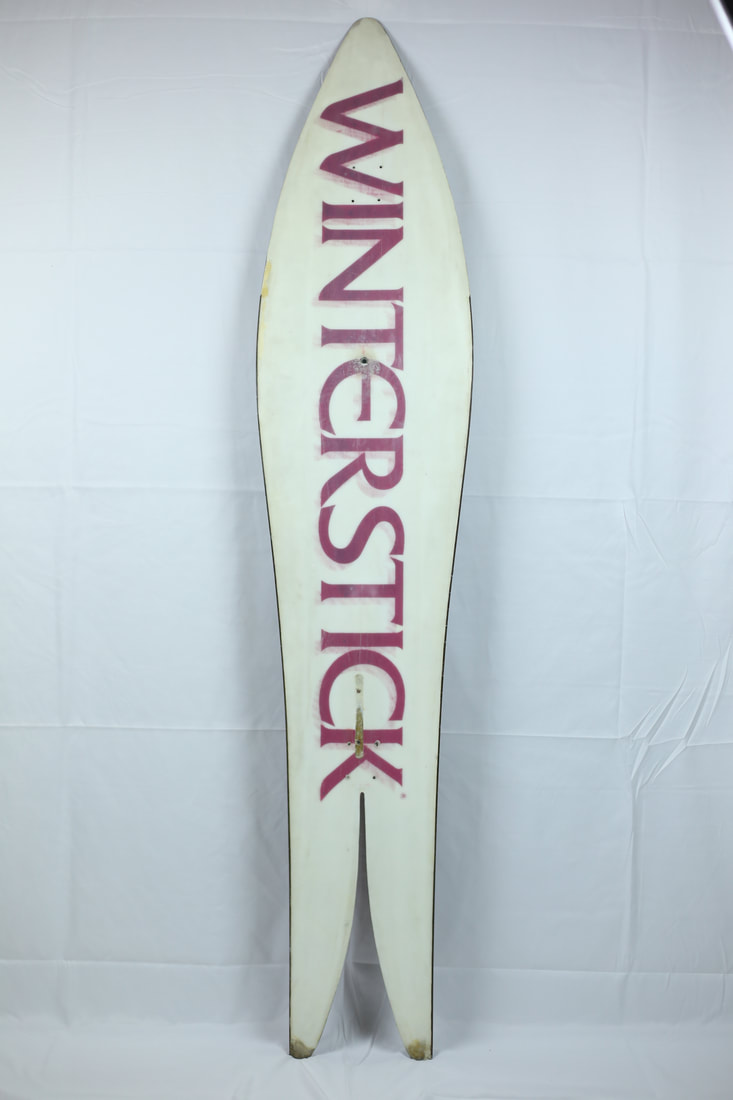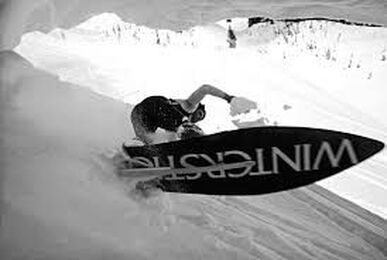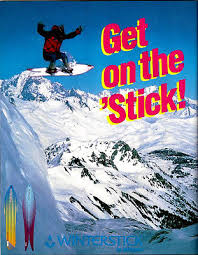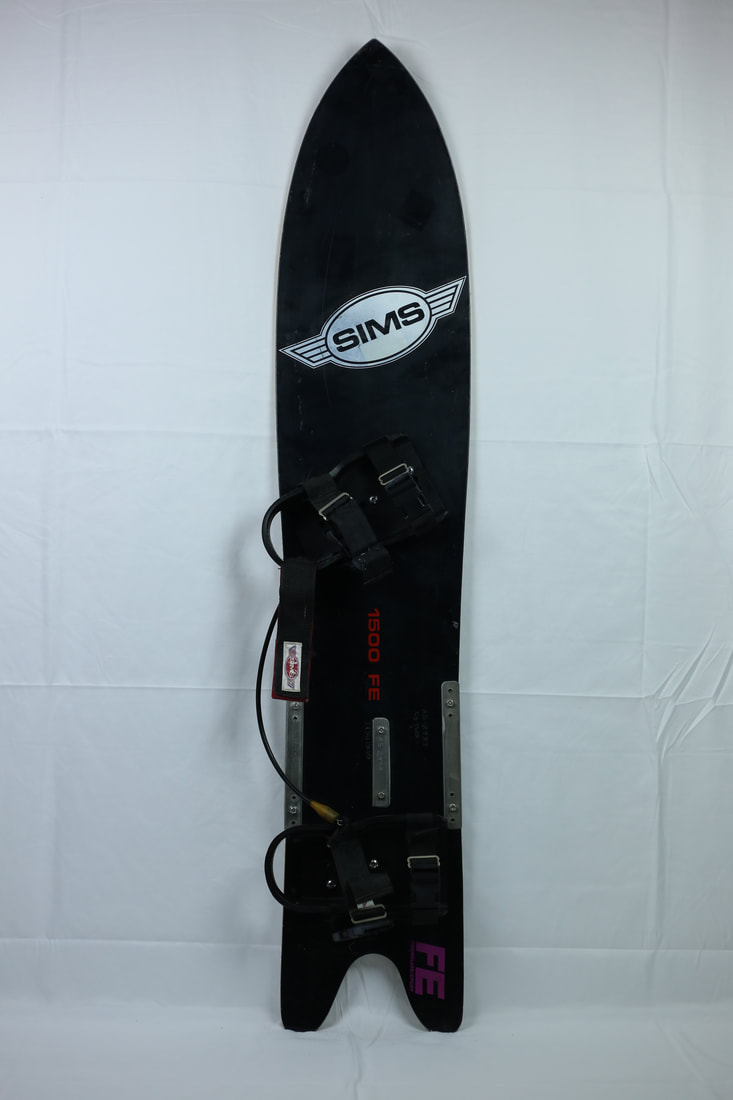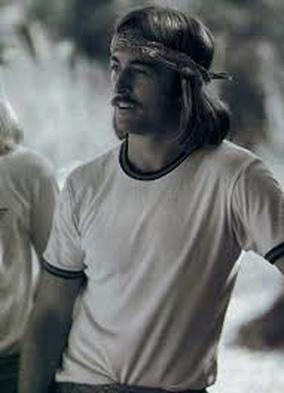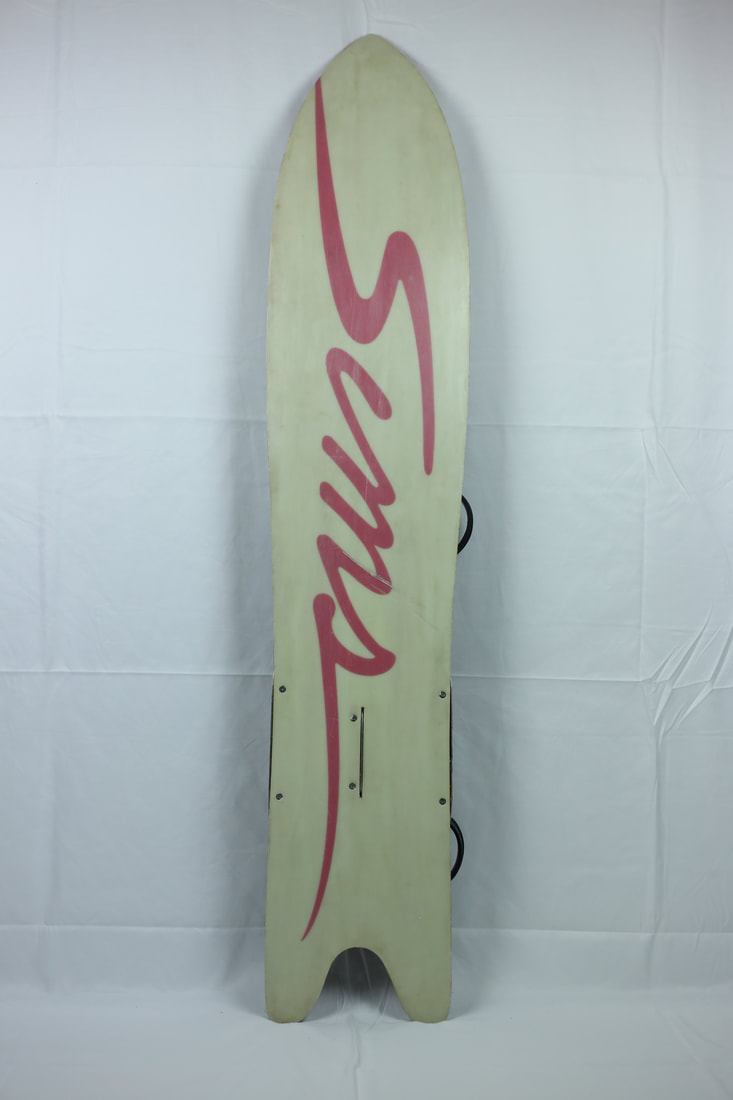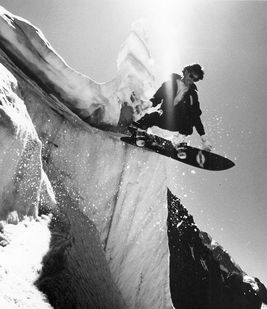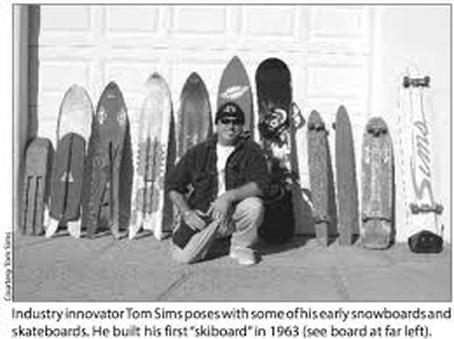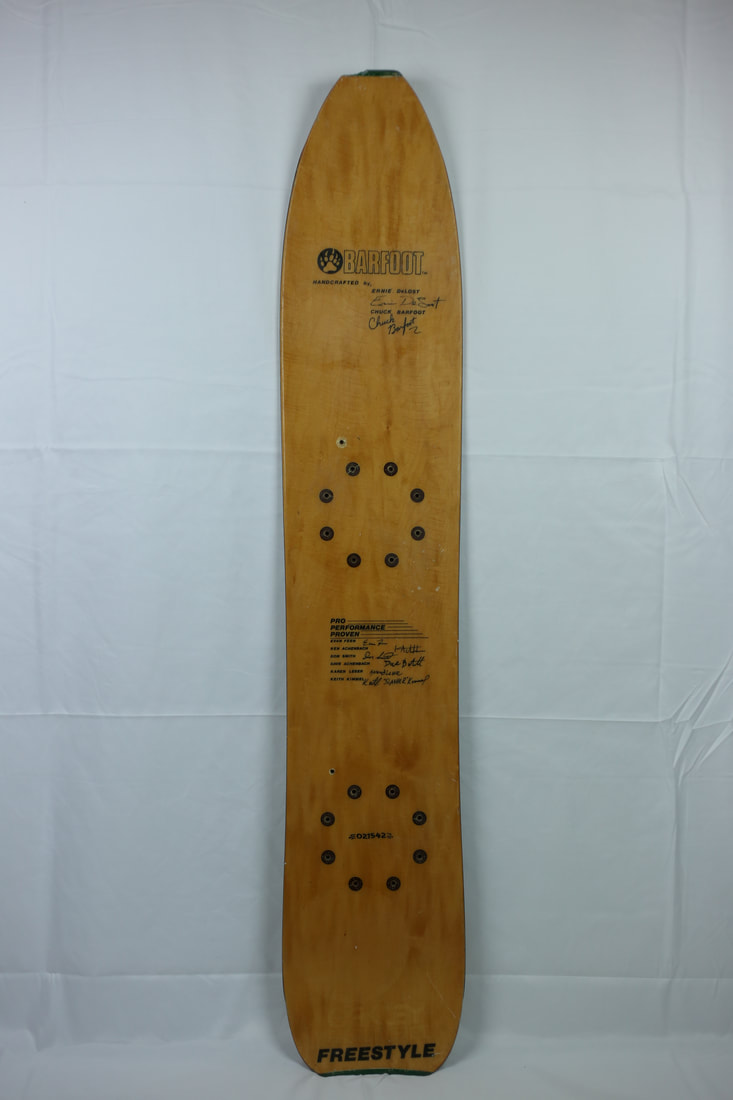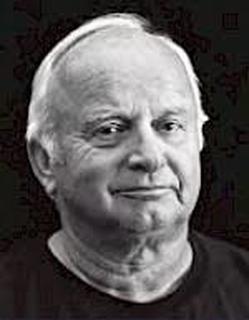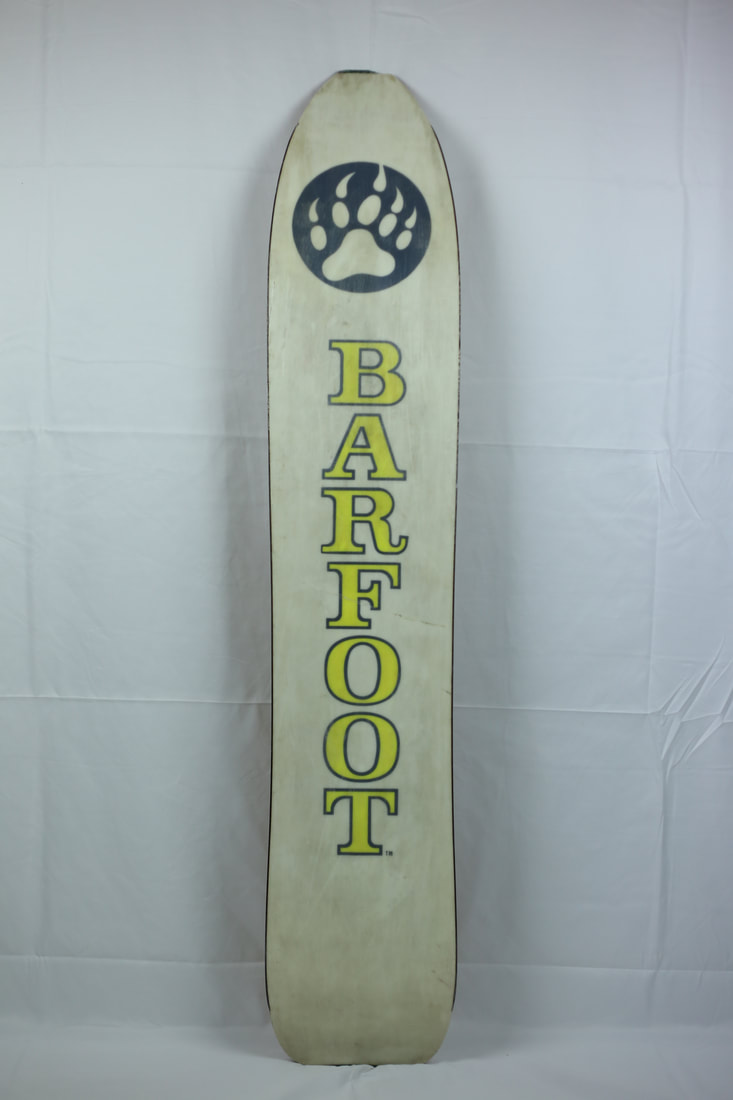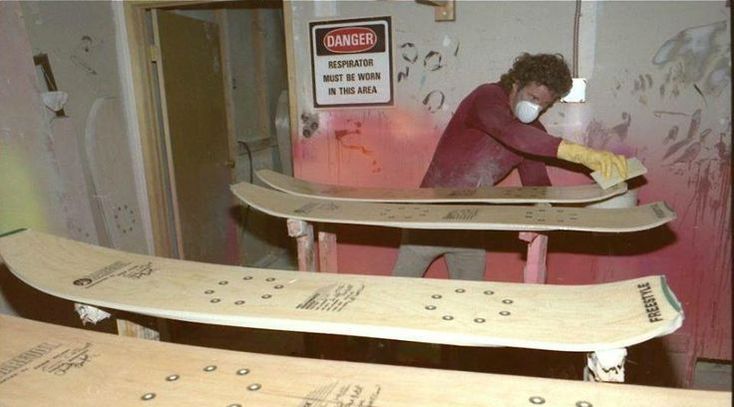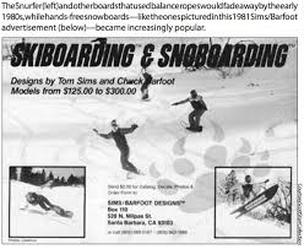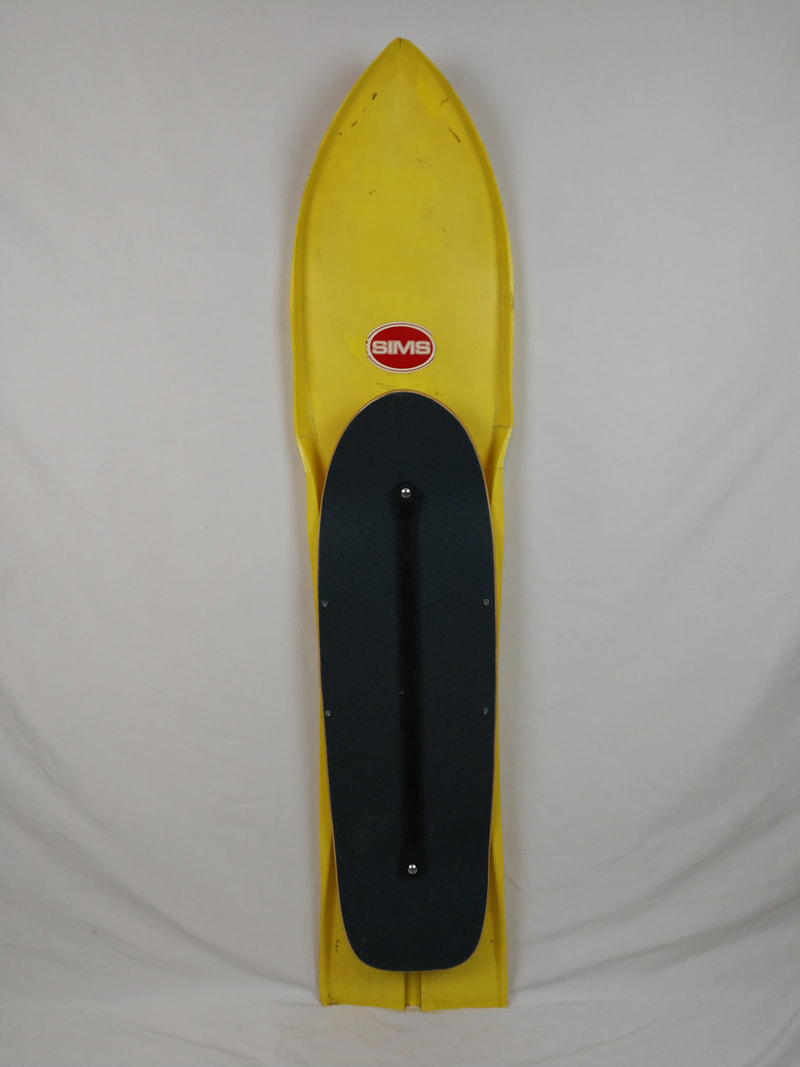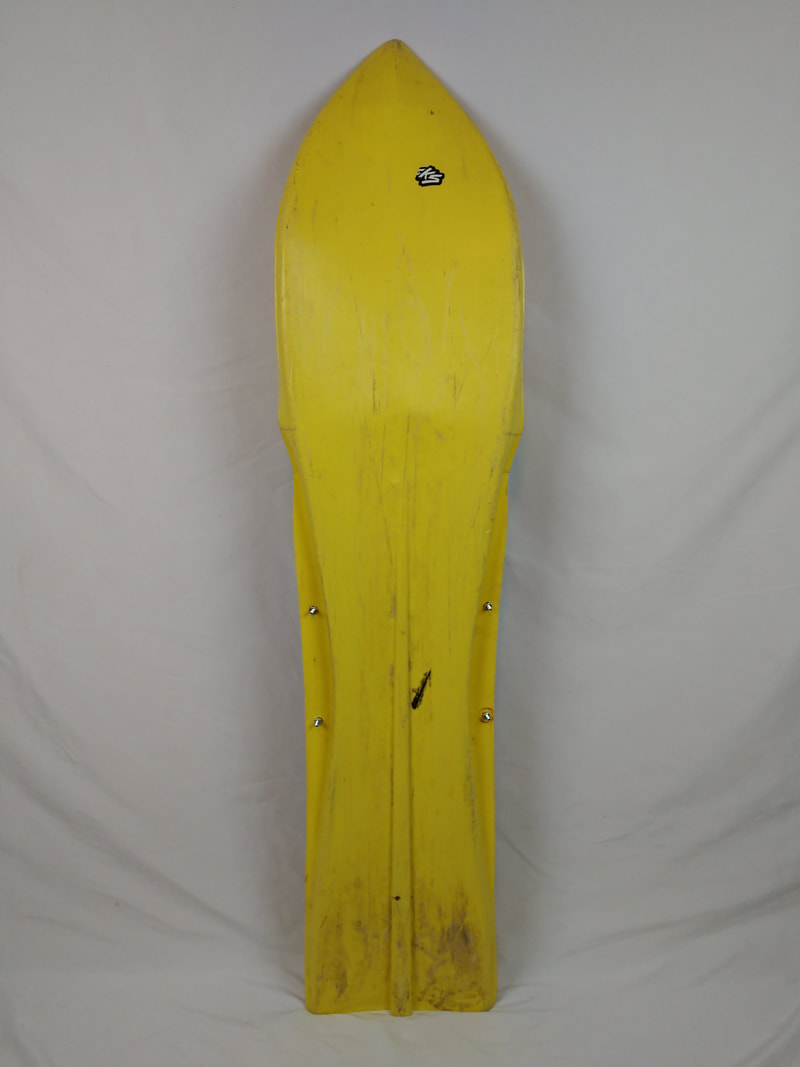- HOME & ABOUT
- EARLY NON-SNOWBOARD SLIDING DEVICES
- A HISTORY OF PROGRESSION, AND ATTEMPTS
- BOARDS FROM THE LEGENDS
- THE SNURFER
- SNURFER KNOCK OFFS
- BURTON - EARLY YEARS TO THE MODERN TWIN
- BURTON - FIRSTS & UNIQUE DECKS
- BURTON - 1980'S ACCESSORIES
- THE "NEON" ERA & OTHER 80'S DECKS
- DECKS WITH A MICHIGAN THEME & CONNECTION
- MICHIGAN LEGENDS AND MORE
- MICHIGAN STREET & PARK VIDS
- MICHIGAN SB PHOTO GALLERY
- MICHIGAN SNOWBOARDING HISTORY TIMELINE
- GLSS - GREAT LAKES SNOW SERIES OF USASA
- MHSSA - MICHIGAN HIGH SCHOOL SNOWBOARD ASSOCIATION
- OLD SNOWBOARD REFERENCE LIST
- CHARITIES, SPONSORSHIP & THANK YOU
- CONTACT
- FINAL WORDS
before answering the question of when, where, and who invented snowboarding, the question of what constitutes a snowboard needs to be answered. is it simply standing sideways? with a stick? with a handle? with a rope? hands free? with foot traction PADS? FOOT BLOCKS FOR BRACING? with a binding? THE EARLY DECK NAMES THEMSELVES "SKI-BOARD VS. SNOW-BOARD"? these questions are what stirs much of the banter over who originated the snowboard. IN SHORT, the dates are disputed and have been pushed back over time, when more info surfaces, but THE real DEBATE BEGINS WITH YOUR PERSONAL DEFINITION.
anecdotes of austrian miners riding a long wooden board called "knappenross" date back to the 1600's. the swiss had a similar board called "rittpritt" from the same era. then reports of an austrian "monogleider" from 1900. there are also memories of u.s. soldiers riding single barrel staves in wwI. however, most of these are largely undocumented, with no physical evidence of a board remaining, and with no influence on modern snowboarding.
other more whimsical stand sideways snow devices that again had little influence on the modern day snowboard are o.j lindberg's 1948 glider sled, arthur juntenen's 1949 toboggan with guide rope, carl e, hagens 1967 rocker toboggan, craig t. christy's skateboard like snow surface rider with bottom rudder and deck blocks to brace feet, joel salisbury's 1968 snow sled surfboard, john fulsom's toboggan with rocker front and rear rudder, james l. ripprtoe's 1968 slalom water snow ski with frOnt foot forward and rear foot ANGLED 45-degreeS; victor t. berta's 1969 deck magnets to keep boots in place, and ronald carreiro's 1971 wakeboard like snow deck with braking device. none of these dented the marketplace.
what has been reasonably proven to exist are the following... most are unaware of the 400 year old tradition of villagers in turkey's kackar mountains sliding down snow standing sideways on toboggan like decks with a balance stick called a "lazboard". then there's the 1920's fixed handle skee-boggan. then the 1930's bunker with stick & rope, BUT once again, even with documented existence and patents in some cases, these had no real influence on modern day snowboArding.
enter the snurfer... boom! this single plank with rope handle was a monumental leap for modern day winter board sports. it inspired a generation of kids an inexpensive way to surf snow (apparently a moscow snurfer club added crude bindings to improve it). regardless, this generation of snurfers and the like, went on to do great things to progress the snowboard and the sport. names like tom sims who claimed to make the first in an 8th grade woodshop class in 1963. then there was Shinzo Tanuma's 1971 moss snowstick prototype. bob webber's ski-board, the webber/sims/barfoot colab flying yellow banana that combined a loni toft skate deck with rubber band bindings above a plastic board. a handful of others including mike oleson (gnu), jack smith (A-Team) chris sanders (avalanche), steve derrah (flite) AND JEFF GRELL (HIGHBACK BINDING), made solid progress. out of this came the heavy hitters jake (burton), dijmitre and partner wayne stoveken (winterstick), and chuck (barfoot) drove progression fast and furious to make snowboarding what it is today and starting point of the modern day snowboard (*see links on the history & progression page for further info on many of the milestones). there were also boards made in garages ahead of the curve who's timing was too early to start a trend. instead of making a definitive statement on the subject, we prefer to honor the individual accomplishments of the following gentlemen's contributions in progressing the "modern day" snowboard, and the contributions of all these pioneers of the sport itself.
here's to american creativity!
* * *
SNURFER- 1ST & 2ed generation SNURFERs
1965 & 1966 (REPRODUCTIONs)
r.i.p. sherm
1965 & 1966 (REPRODUCTIONs)
r.i.p. sherm
When Sherman Poppen signed an autograph he usually included the date “12-25-65” and the words “Ride On”. It was on this date in Muskegon, Michigan, with his kids rambunctious after opening presents, and a pregnant wife wanting them outside, that Sherman fixed two jc PENNEY KIDS skis together out in the garage for them to ride on, and made history. Little did he realize at the moment that he would be positively impacting the lives of millions of kids around the country.
There is no other person from the State of Michigan who has even remotely influenced snowboarding more than Sherman Poppen. In fact, due to the Snurfer, he’d be considered one of the virtual "five Great Lakes" of snowboarding influence. SHERMAN WAS a courteous and giving person his entire life.
The museum reproduced this snurfer based on the best photographs available of Sherm's original Snurfer. The original resides in the Colorado Ski & Snowboard Museum and is priceless. A later model Snurfer resides in the Smithsonian Institution, Washington, DC, as a testament to it's influence on the sport of snowboarding. This board consists of pine kids skis, rubber traction matting, galvanized steel heel plates, and simple wood braces screwed together to hold the skis side by side. The markings were carefully applied and aged to mimic those of the original Snurfer. Simply stated, this rudimentary device altered the course of winter sports forever and inspired the coming storm of innovation in the decades that followed. for a complete history on snurfers and snurfing visit the link on the history of progression page.
There is no other person from the State of Michigan who has even remotely influenced snowboarding more than Sherman Poppen. In fact, due to the Snurfer, he’d be considered one of the virtual "five Great Lakes" of snowboarding influence. SHERMAN WAS a courteous and giving person his entire life.
The museum reproduced this snurfer based on the best photographs available of Sherm's original Snurfer. The original resides in the Colorado Ski & Snowboard Museum and is priceless. A later model Snurfer resides in the Smithsonian Institution, Washington, DC, as a testament to it's influence on the sport of snowboarding. This board consists of pine kids skis, rubber traction matting, galvanized steel heel plates, and simple wood braces screwed together to hold the skis side by side. The markings were carefully applied and aged to mimic those of the original Snurfer. Simply stated, this rudimentary device altered the course of winter sports forever and inspired the coming storm of innovation in the decades that followed. for a complete history on snurfers and snurfing visit the link on the history of progression page.
|
Model of 15' Poppen tribute-Downtown Muskegon, MI
|
BLOCKHOUSE HILL, HOME OF EARLY SNURFING COMPS
MUSKEGON STATE PARK, MI |
* * *
BURTON - BBII "LONDONDERRY" (1979/1980)
r.i.p jake
r.i.p jake
When it comes to rebellious and cantankerous behavior, Vermonters go way back. They didn’t join the original 13 colonies in the Union until 1791, four years after the Constitution was signed. Before that, Vermont had been its own stand-alone republic for 14 years. George Washington once wrote a letter containing the line “I wouldn’t mess with Vermonter's”, in reference to their independent and rebellious political nature. just Maybe the effect of this history subconsciously trickled down to Jake Burton carpenter? IT ALL STARTED IN NORTH ANDOVER, maSS, WHEN 14 YEAR OLD JAKE STEPPED ON TO A FRIENDS BUMBLEBEE STRIPED SNURFER. LATER JAKE went on to become a talented skier, and attended the University of Colorado hoping to join the ski team before breaking a collar bone. Upon graduating from NYU, Jake worked in the world of finance for a bit, but never forgot his TEENAGE Snurfer days and set about establishing the Burton brand in 1977 after developing fiberglass prototypes. The early production boards are known as BBI and BBII (Burton Backhill I=without binders, II=with binders) or also referred as simply “Londonderry’s” because they were built in jakes Londonderry, VT factory. Jake's mission was to prove that these planks had a much bigger future than the toy Snurfer. With the addition of rubber binders and the ability to adjust them on the fly without tools, Burton had a bright future and never looked back. He continued to push design, innovation, and compete - all THE while lobbying ski areas to accept snowboarding which he knew was the key to selling more boards and progressing the sport. IN 1983 HE CONVINCED STRATON MT., vt TO SELL LIFT TICKETS TO SNOWBOARDERS - THE FIRST RESORT TO DO SO. No one has done more to propel the sport forward in becoming what it is today - period. Perhaps Jake and his wife Donna’s most proud accomplishment is the CHILL Foundation, which helps under served youth build self-esteem through board sports.
Everything on the board is original, except the replacement handle and rope. Original handles were molded red plastic. The BURTON font on the rear binding strap was originally solid in color, however oxidation of the paint has occurred over time leaving only the crisp outline. The rubber bindings are still pliable, matting intact, fins, thumb screws, and hardware and especially the graphics are all in great condition. The board was supposedly purchased by a childhood friend of the Heingartner family, which in turn was connected to Jake. Tom Heingartner being an original Burton Team rider that competed all around the country. The original owner noted that this board saw limited use on golf course hills (resorts didn't allow snowboarding then) and later, a day or two use at Bromley Mountain in Peru, Vermont.
In 1979, Jake drove to the Snurfer World Championships at Pando Resort in Belmont, MI. His plan was to compete, win, and thus promote his boards in the process. The event sponsors initially disallowed Jake's more advanced BBII board with bindings, but to their credit, created a new category as a compromise.
Everything on the board is original, except the replacement handle and rope. Original handles were molded red plastic. The BURTON font on the rear binding strap was originally solid in color, however oxidation of the paint has occurred over time leaving only the crisp outline. The rubber bindings are still pliable, matting intact, fins, thumb screws, and hardware and especially the graphics are all in great condition. The board was supposedly purchased by a childhood friend of the Heingartner family, which in turn was connected to Jake. Tom Heingartner being an original Burton Team rider that competed all around the country. The original owner noted that this board saw limited use on golf course hills (resorts didn't allow snowboarding then) and later, a day or two use at Bromley Mountain in Peru, Vermont.
In 1979, Jake drove to the Snurfer World Championships at Pando Resort in Belmont, MI. His plan was to compete, win, and thus promote his boards in the process. The event sponsors initially disallowed Jake's more advanced BBII board with bindings, but to their credit, created a new category as a compromise.
|
Worlds first snowboard factory
|
MUSKEGON NEWS ARTICLE ON JAKE BURTON 1979
(PICTURE AT muskeegon community college, MI 1979) |
jake's Snurfer Trophy from Muskegon, mi (pic courtesy todd kohlman "TK" burton snowboard co. archivist)
* * *
WINTERSTICK - SWALLOW TAIL PLUS (1986)
Dimitrije Milovich’s odessy began with sliding down snowy hills on cafeteria trays while at Cornell University. In 1972 he moved west to pursue making snowboard prototypes to test in the Utah powder. He and partner Wayne Stoveken obtained patents for “snow surfboards” with traction, boot straps and no rope. They began sales through a shop in Salt Lake City, Utah. His vision of "surfing" on snow meant traction was required. Early prototype tops experimented with adhering wood strips, shredded plastic, broken glass and even aquarium pebbles allowing riders to shift their feet anywhere on the deck and retain traction like a surfers use of grip wax. Bottoms were also revolutionary by allowing the frozen liquid to be directed into two lateral channels to increase speed. They continued their revolutionary push with essential features including a polyethylene base, polyurethane middle, and fiberglass. They were also the first to create and market two distinct shapes - a round tail for hard pack, and an exaggerated swallow tail for deep powder. Winterstick closed shop 10 years later when Dimitrije opened the successful Radius Engineering, Inc. Although Dimitrije is no longer involved with Winterstick, the brand has since been brought back to life by a group in Colorado handcrafting powder focused designs, utilizing only solar and wind energy in their small factory. It is hard to understate Dimitrije's influence of early snowboard innovation and design.
|
Dimitrije "Surfing"
|
1986 Magazine Advertisement Showing Round and Swallow Tail Designs (similar to MSM board above)
|
* * *
SIMS - 1500 FE (1984) R.I.P. Tom
First and foremost, Tom Sim's claimed to have invented the first snowboard in middle school shop class in 1963. Undisputed however, is Tom’s skill on any board, becoming an icon in 1976 after becoming skate boarding’s World Champion. Along with his employee Chuck Barfoot, the two introduced the Flying Yellow Banana Skiboard for the 1978-1979 season – a skateboard type deck on top of a plastic shell. Sim’s went on to introduce metal edges, heel & toe bindings, big mountain and freestyle snowboards. He was also instrumental in establishing early contests and was one of the first to ride the wash gully at the Tahoe City Dump, considered the world’s first halfpipe. This eventually led to the first halfpipe and freestyle events at the World Championships at Soda Springs, CA in 1983. The Sims team included the best snowboarders in the world, and when the #1 Pro Craig Kelley switched from Sims to Burton it created the infamous decade long clash between Sims and Burton. Tom passed in 2012 but his memory and contributions to the sport will never die.
This board's ties to Michigan are it's similarity to the FE (Fiberglass Epoxy) Snowboard used in the 1985 James Bond Movie "A View To A Kill". Midland Michigan native and podium finisher at 1983 US Nationals and 1984 World Championships, snowboarder Steve Link, was invited by the Bond film producers to appear with Tom as a stunt double during six weeks of filming in Piz Palu, at the foot of the Pers Glacier bordering Switzerland and Italy. Looking up this classic scene in the movie is a must!
This board is one of the early famous FE (Fiberglass-Epoxy) models with all the bells and whistles including steel edges, steel skegs, adjustable fiberglass bindings, safety strap, and split tail.
This board's ties to Michigan are it's similarity to the FE (Fiberglass Epoxy) Snowboard used in the 1985 James Bond Movie "A View To A Kill". Midland Michigan native and podium finisher at 1983 US Nationals and 1984 World Championships, snowboarder Steve Link, was invited by the Bond film producers to appear with Tom as a stunt double during six weeks of filming in Piz Palu, at the foot of the Pers Glacier bordering Switzerland and Italy. Looking up this classic scene in the movie is a must!
This board is one of the early famous FE (Fiberglass-Epoxy) models with all the bells and whistles including steel edges, steel skegs, adjustable fiberglass bindings, safety strap, and split tail.
|
Steve Link "dropping in" - Utah 1984
(Similar to msm collection board) |
Tom's design evolutions
|
* * *
BARFOOT - FREESTYLE "WOODY" (1985/86)
The beauty of this Chuck Barfoot WOODY lies in it's simplicity, with only the brand, model, and logo on a vertically laminated ply board. It came with and without edges, this board having the edge upgrade. Since Chuck worked with Tom Sims prior to starting his own company, this board understandably has some shape influences from that experience. Chuck was ahead of his time by using ¼-20 hardware and a simple but beautiful whole pattern that allowed for more stance options than other brands. These boards were one of the first to have inserts instead of drill through t-nuts. a 3/4" hole was drilled halfway through the blank, and inserts glued in, epoxy was then used to secure the threads in place before sanding and ADDING THE fiberglass top layer. This made for an unobstructed base and multiple binding settings. The serial number =021542= indicated that this was the 42ed board finished off on February 15, likely in 1986. As the board itself states, it may have some handcraft work done by Chuck and his right hand man Ernie DeLost. Proven by legendary Pro’s including the Achenbach brothers, it’s a very desirable piece of snowboard history. Chuck remains a true pioneer of the sport with unmeasurable passion who still makes planks on a limited basis today. A man who’s lived and supported his lifestyle around board sports, he remains an active icon. Although his passion is surfing, his skateboard and snowboard skills were poetry in motion. He remains committed, and as they... “claw be the law”.
|
Barfoot Workshop, Santa barbara, CA 1986
|
1981 Barfoot-SIMS Designs Advertisement
|
* * *
WEBBER/sims/BARFOOT/winkels/toft - FLYING YELLOW BANANA (1978)
IN 1977 BOB WEBBER CONTACTED SIMS SKATEBOARDS. WEBER HAD BEEN WORKING ON HIS OWN VERSION OF THE SNOWBAORD AND SOUGHT OUT SIMS EMPLOYEES TOM SIMS AND AND CHUCK BARFOOT. BOB HAD ALREADY TRADEMARKED THE TERM "SKIBOARD" IN 1975, AND PATENTED HIS OWN VERSION OF A SNOWBOARD CALLED THE "MONOSKI" IN THE SAME YEAR. THE THREE AND OTHERS NOTED BELOW WORKED TOGETHER TO CREATE THIS LEGENDARY "FLYING YELLOW BANANA" WHICH BLENDED SKATE AND SNOW PLATFORMS TOGETHER. THE YELLOW DECK CREDITED TO WEBER. THE SKATEBOARD DECK CREDITED TO WEE WILLIE WINKLES AND ALSO LONNIE TOFT, WITH SIMS AND BARFOOT BRINGING IT ALL TOGETHER UNDER THE SIMS BRAND.
THIS BOARD SPENT IT'S LIFE IN GENNESSEE COUNTY MICHIGAN. IT WAS USED EXTENSIVELY BY A TRIO OF TEENAGERS FROM THE FLINT AREA. IT WAS RIDDEN AT FLINT MOTT GOLF COURSE, SCHWARTZ CREEK GOLF COURSE, AND SOUTHWESTERN HIGH SCHOOL. ONE OF THEIR FAVORITE ACTIVITIES WAS RIDING IT ON CORN FIELD SNOW DRIFTS WHILE BEING PULLED BY ATV'S.
ALTHOUGH HEAVILY USED, THE BASE OF THIS BOARD IS SOMEWHAT STURDY AND REMAINED INTACT. ORIGINAL SKATE DECKS AFFIXED TO THE SNOWBOARD DECKS CAME WITH 1 OF 3 DIFFERENT LONNIE TOFT VARIATIONS (ACCORDING TO MICHAEL HESS, AN OG TOFT CRAFTSMAN). THUS, THE DECKS WERE NOT NECESSARILY DESIGNED TO WITHSTAND MOISTURE AND HAVE USUALLY BEEN REPLACED OVER TIME. THE lonnie toft SKATE DECK ON THIS BANANA, the bungee and related hardware are replacements.
THIS BOARD SPENT IT'S LIFE IN GENNESSEE COUNTY MICHIGAN. IT WAS USED EXTENSIVELY BY A TRIO OF TEENAGERS FROM THE FLINT AREA. IT WAS RIDDEN AT FLINT MOTT GOLF COURSE, SCHWARTZ CREEK GOLF COURSE, AND SOUTHWESTERN HIGH SCHOOL. ONE OF THEIR FAVORITE ACTIVITIES WAS RIDING IT ON CORN FIELD SNOW DRIFTS WHILE BEING PULLED BY ATV'S.
ALTHOUGH HEAVILY USED, THE BASE OF THIS BOARD IS SOMEWHAT STURDY AND REMAINED INTACT. ORIGINAL SKATE DECKS AFFIXED TO THE SNOWBOARD DECKS CAME WITH 1 OF 3 DIFFERENT LONNIE TOFT VARIATIONS (ACCORDING TO MICHAEL HESS, AN OG TOFT CRAFTSMAN). THUS, THE DECKS WERE NOT NECESSARILY DESIGNED TO WITHSTAND MOISTURE AND HAVE USUALLY BEEN REPLACED OVER TIME. THE lonnie toft SKATE DECK ON THIS BANANA, the bungee and related hardware are replacements.
* * *
- HOME & ABOUT
- EARLY NON-SNOWBOARD SLIDING DEVICES
- A HISTORY OF PROGRESSION, AND ATTEMPTS
- BOARDS FROM THE LEGENDS
- THE SNURFER
- SNURFER KNOCK OFFS
- BURTON - EARLY YEARS TO THE MODERN TWIN
- BURTON - FIRSTS & UNIQUE DECKS
- BURTON - 1980'S ACCESSORIES
- THE "NEON" ERA & OTHER 80'S DECKS
- DECKS WITH A MICHIGAN THEME & CONNECTION
- MICHIGAN LEGENDS AND MORE
- MICHIGAN STREET & PARK VIDS
- MICHIGAN SB PHOTO GALLERY
- MICHIGAN SNOWBOARDING HISTORY TIMELINE
- GLSS - GREAT LAKES SNOW SERIES OF USASA
- MHSSA - MICHIGAN HIGH SCHOOL SNOWBOARD ASSOCIATION
- OLD SNOWBOARD REFERENCE LIST
- CHARITIES, SPONSORSHIP & THANK YOU
- CONTACT
- FINAL WORDS

